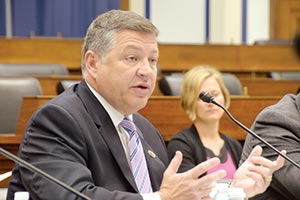Senior Reporter
Shuster Says Truck-Only Lanes Could Help Unclog Bottlenecks

This story appears in the April 18 print edition of Transport Topics.
WASHINGTON — During a rare hearing focused exclusively on the commercial motor carrier industry, the chairman of the House Transportation and Infrastructure Committee suggested his colleagues support establishing truck-only lanes to help boost freight capacity.
“We are going to see the doubling in the next 20 years or so of freight traffic, and then doubling again. So this is something — it’s a capacity issue that we have to face,” Rep. Bill Shuster (R-Pa.) said here April 13 during a roundtable-style hearing.
Shuster stressed his commitment to address the need for capacity along freight corridors, not only to increase capacity but to enhance safety.
“I certainly have a great concern, as I think we all do, of making sure that the roads are as absolutely safe as possible,” Shuster said.
The hearing marked the first opportunity for industry leaders to voice their concerns about the five-year FAST Act highway law enacted in December, which set in motion reforms for trucking regulators.
The event featured officials with American Trucking Associations, the Owner–Operator Independent Drivers Association and the Commercial Vehicle Safety Alliance.
Dave Osiecki, ATA’s chief of national advocacy, shared Shuster’s concern regarding capacity.
“We do have a capacity problem. We don’t have enough funding for our system. I think we all know that,” Osiecki said. “We need to figure out as a country, as an industry, and as a Congress a better way to fund our infrastructure — highway infrastructure — going forward.”
Congress sought to address capacity issues by authorizing $4.5 billion through 2020 for a grant program in the FAST Act designed to assist states with funding infrastructure projects. For fiscal 2016, the U.S. Department of Transportation made available $800 million in grants for critical freight projects.
A study DOT unveiled last year, titled “Beyond Traffic,” warned of the economic harm traffic bottlenecks have on freight deliveries. The study also proposed approving big-picture freight funding programs and private investment in highway infrastructure.
Besides concerns about capacity, Osiecki touched on a battery of unresolved issues, such as Compliance, Safety, Accountability scoring and hours of service. He also called on lawmakers to ensure a hair-testing option to screen truckers for drugs is implemented.
Osiecki applauded the FAST Act’s reforms to the Federal Motor Carrier Safety Administration’s regulatory process pertaining to the use of reliable data and cost-benefit analyses for new rules. But he added that a “Beyond Compliance” program at FMCSA presents a “real partnership opportunity” between regulators and the industry. The voluntary compliance incentives program was established by the FAST Act.
During the hearing, OOIDA Executive Vice President Todd Spencer took issue with the CSA program, telling lawmakers his group strongly views the scores as inaccurate and misleading.
“Small business is one of those that can be seriously and detrimentally impacted by this particular program,” Spencer said.
The watchdog group Advocates for Highway and Auto Safety participated in the roundtable. Cathy Chase, the group’s vice president of governmental affairs, criticized lawmakers who would back attaching a technical HOS provision in fiscal 2017 funding legislation.
“Special-interest riders allowing industry to write their own rules of the road without any public agency or expert input is unacceptable,” Chase said.
Bill Quade, FMCSA’s associate administrator for enforcement, took heat from Rep. Richard Hanna (R-N.Y.) over the agency’s ongoing review of its HOS rule.
“You pushed people into hours that actually not only made them less efficient but more dangerous, and that was never taken into account, yet we’ve heard about that widely from everybody that is the case,” Hanna said.
Quade defended the agency’s HOS policies as well as its portfolio of regulations.
Lawmakers also pressed trucking stakeholders on the proposed rule from FMCSA that would establish guidelines for determining which trucking firms are fit to operate. The industry has expressed concerns about this safety fitness determination proposal over its use of FMCSA data.
The FAST Act also established the Motor Carrier Safety Assistance Program Formula Working Group. On April 11, DOT named the group’s participants, who will be tasked with analyzing requirements and factors for establishing a new allocation formula for FMCSA’s flagship state grant program.
“I look forward to receiving the working group’s recommendations on how we can enhance and streamline this important safety grant program with the ultimate goal of making our nation’s roads safer,” Transportation Secretary Anthony Foxx said.
The program maintains the states’ commercial motor vehicle enforcement programs while providing critical support for state-conducted compliance investigations, roadside inspections, new entrant audits and traffic enforcement activities.
State safety agency participation must make up at least 51% of the working group.

